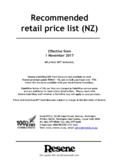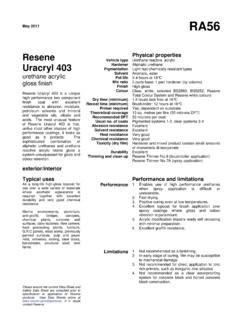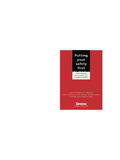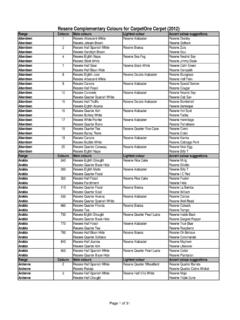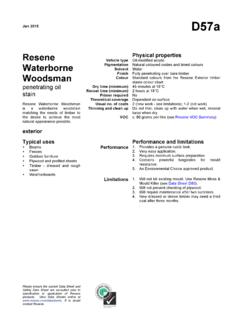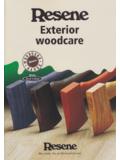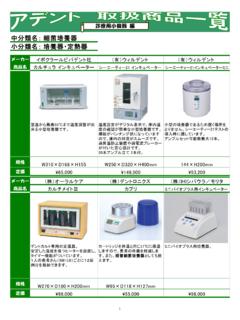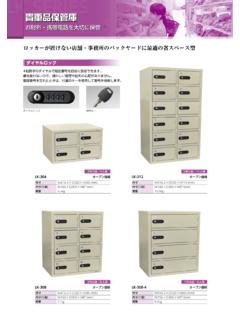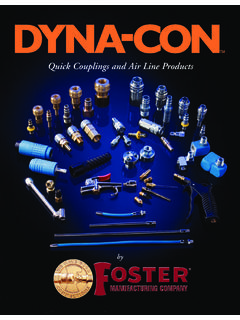Transcription of Recommended paint systems - resene.co.nz
1 Recommended paint systemsPreparationThe better the preparation the better the resulting paint finish. While this may conjure up images of hours of tedious sanding and scraping, this shouldn t be the case for most brochure simplifies and explains the typical steps you will need to follow before painting. At Resene we stock quality preparation tools and application equipment matched to our Recommended paint systems . This is the essence of what we call Resene Best System following are important steps that need to be followed before applying paint . It isn t by any means exhaustive but should cover the key areas for you, together with recommendations for the equipment you will need.
2 At Resene we are happy to inspect your own brushes and rollers and other painting equipment to make sure they are suitable for your planned decorating key steps for preparing interior surfaces are described below and exterior surfaces are covered overleaf. Data Sheet references are included in this brochure for quick reference for example, (D52) refers to Data Sheet number D52. We recommend you take the time to read product and accessory labels before use and if you are unsure about any aspect of your project and would like additional information or tips, or would like copies of the Data Sheets referred to, please contact Resene or visit the Resene 1 WashingWashing before painting interior walls, ceilings and joinery etc is good practice to remove any fly dirt, dust and other contaminants.
3 In most situations this means simply wiping using a clean lint-free cloth and a solution of warm water and Resene Interior Paintwork Cleaner or a mild detergent. Sanding walls and ceilings is not usually necessary unless the surface has imperfections and/or flaking paint that needs to be sanded smooth, or if the existing paint system is an old enamel system 1. If it is an enamel system, commonly used in kitchen and bathroom areas and on joinery and doors, first remove any grease and oil using sugar soap and sand the areas to degloss the surface and provide a key for the paint to adhere to.
4 Alternatively Resene Waterborne Smooth Surface Sealer (D47a) could be used eliminating the requirement to 1: Pen marks will need to be sealed with either Resene Sureseal (D42) or Resene Enamel Undercoat (D44) as they will bleed through waterborne paints. Note 2: You can check whether the paint finish is an enamel system by rubbing the paint surface with meths. If it removes some of the coating then it is most likely waterborne and a Resene paint system can be applied directly onto the clean surface without 2 FillingAny holes or voids, such as those left in wallboards by picture hooks, should be filled and once dry sanded smooth.
5 Unless the hole in the wallboard is large (say bigger than the palm of your hand) it will not usually need sealing or priming before timber joinery it is good practice to spot prime voids and holes, such as punched nailheads, before filling and then reprime once filled and sanded. The tables below are guides to the most suitable sandpaper, fillers and primers/sealers to are now ready to and scrapingAreaScraperFirst sandpaperFinishing sandpaperFine finishing clear finishes 220 grit zinc stearate400 grit Wet and DryRough and/or flaking woodwork or wall linings25-50mm flat bladed scraper100 grit zinc stearate220 grit zinc stearateSanding between coats, enamels, clear finishing 220 grit zinc stearate Sanding fillers for joinery.
6 Skirting boards etc 180 grit zinc stearate Sanding fillers on wall linings 220 grit zinc stearate Sanding wallboards after removing wallpaper 80 grit zinc stearate Wallboard compounds, Resene Broadwall Surface Prep & Seal (D807), Resene Broadwall Waterborne Wallboard Sealer (D403) 180-220 grit zinc stearate ideally with a pole sander FillersSubstrateRecommendedAlternativeNo teGaps between scotia, skirting boards and door and window framesSIKA Fill That GapPAL Zero GapsRefer pack instructionsHoles/voids in timber and MDF joineryPAL Contract FillerSelleys Permafill Small holes, dents etc in wallboards ( picture hook holes)
7 Selleys RapidfillaPAL Contract FillerAsk your Resene ColorShop staff or contact the Resene helpline for advice if the wallboard itself has been damaged or punched throughPrimingSubstrateNewAgedCedar joineryResene Enamel Undercoat (D44)Resene Enamel Undercoat (D44)Laminated surfaces Resene Waterborne Smooth Surface Sealer (D47a)MDFR esene Quick Dry Waterborne Primer Undercoat (D45)Resene Quick Dry Waterborne Primer Undercoat (D45)Old varnish/polyurethane Resene Waterborne Smooth Surface Sealer (D47a)Paperfaced plasterboardResene Broadwall Waterborne Wallboard Sealer (D403)Resene Sureseal (D42)Timber joineryResene Quick Dry Waterborne Primer Undercoat (D45)Resene Quick Dry Waterborne Primer Undercoat (D45)Vinyl wallpaper Resene Vinyl Wallpaper Sealer (D406)Water stains/pen and ink marks Resene Sureseal (D42)InteriorWalls/ceilings Select preparation required and then combine with the room to be painted to complete the systemAreaRecommended systemKey accessoriesNotesWallboard and ceiling preparationNew paperfaced plasterboard Level 4 Ensure surface is sanded smooth.
8 Seal with Resene Broadwall Waterborne Wallboard Sealer (D403). Once dry fill any gaps or roller grit zinc stearate sand after applying Resene Broadwall Waterborne Wallboard Sealer (D403) to remove any nibs or rough paperfaced plasterboard Level 5 Ensure surface is sanded smooth. After sanding, apply Resene Broadwall Surface Prep & Seal (D807). Once dry fill any High Solids roller for Resene Broadwall Surface Prep & Seal (D807).Resene roller sleeve for grit zinc stearate Level 5 finish is Recommended for areas with critical light issues and for use under metallics.
9 If a Level 5 finish has already been achieved by a plasterer, Resene Broadwall Surface Prep & Seal (D807) is not required, but a sealer such as Resene Broadwall Waterborne Wallboard Sealer will areasReplace Resene Broadwall Waterborne Wallboard Sealer (D403) with Resene Sureseal (D42).Stripping wallpaperAfter removing wallpaper, roughly sand to remove surface imperfections. Fill any dents and scraper cuts. Apply Resene Sureseal (D42) followed by Resene Broadwall Surface Prep & Seal (D807) lightly sanding between coats. Fill gaps after Fill That Gap or Selleys grit sandpaper (depending on how rough the wall is), 220 grit sandpaper for sanding Resene Broadwall Surface Prep & Seal (D807).
10 Resene Sureseal (D42) will hold back stains from yellowed wallboard and residual glue that will bleed through waterborne paints. Resene Broadwall Surface Prep & Seal (D807) will significantly improve the finish. An alternative is to use lining using Resene Interior Paintwork Cleaner (concentrate) correctly diluted with water and a lint-free cloth to remove dirt, marks, etc. Fill any voids, holes from picture hooks, Fill That Interior Paintwork Cleaner (concentrate).220 grit a wall in good condition is straightforward. Resene paints will stick to most surfaces without the need to sand.
